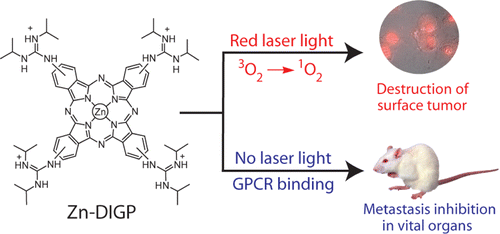First dual-action compound kills cancer cells, stops them from spreading

Scientists are reporting development and successful lab tests on the first potential drug to pack a lethal one-two punch against melanoma skin cancer cells. Hit number one destroys cells in the main tumor, and the second hit blocks the spread of the cancer to other sites in the body, according to their report in the journal ACS Chemical Biology.
Nathan Luedtke and colleagues explain that the spread of melanoma and other forms of cancer beyond the original location—a process called metastasis—makes cancer such a serious disease. Photodynamic therapy (PDT), which involves administering a drug that kills cancer cells when exposed to light, already is available. But PDT works only on the main tumor and has other drawbacks. Luedtke's team set out to find an improved approach to PDT.
The scientists describe successful tests in laboratory mice of one compound they synthesized that not only killed melanoma cells, but also stopped them from metastasizing by blocking a key signal inside the tumor cells. The compound "provides the first example of a preclinical candidate possessing both of these properties," the scientists state.

The article is titled "Photodynamic Agents with Anti-metastatic Activities."
More information: Photodynamic Agents with Anti-metastatic Activities, ACS Chem. Biol., Article ASAP. DOI: 10.1021/cb400008t
Abstract
A new concept in multifunctional anticancer agents is demonstrated. Tetrakis-(diisopropyl-guanidino) zinc phthalocyanine (Zn-DIGP) exhibits excellent properties as a photodynamic therapy (PDT) agent, as well as potential anti-metastatic activities in vivo. Zn-DIGP exhibits good cellular uptake and low toxicity in the dark (EC50 > 80 μM) and is well tolerated upon its intravenous injection into mice at 8 mg/kg. Upon photoexcitation with red laser light (660 nm), Zn-DIGP exhibits a high quantum yield for singlet oxygen formation (Φ ≈ 0.51) that results in potent phototoxicity to cell cultures (EC50 ≈ 0.16 μM). Zn-DIGP is also capable of inhibiting the formation of tumor colonies in the lungs of C57BL/6 mice injected with B16F10 cells. Zn-DIGP therefore inhibits cancer growth by both light-dependent and light-independent pathways. The anti-metastatic activities of Zn-DIGP possibly result from its ability to interfere with the signaling between chemokine CXCL10 and the G protein-coupled receptor CXCR3. Zn-DIGP is a competitive inhibitor of CXCR3 activation (IC50 = 3.8 μM) and selectively inhibits downstream events such as CXCL10-activated cell migration. Consistent with the presence of feedback regulation between CXCR3 binding and CXCL10 expression, Zn-DIGP causes overexpression of CXCL10. Interestingly, Zn-DIGP binds to CXCR3 without activating the receptor yet is able to cause endocytosis and degradation of this GPCR. To the best of our knowledge, Zn-DIGP is the first PDT agent that can facilitate the photodynamic treatment of primary tumors while simultaneously inhibiting the formation of metastatic tumor colonies by a light-independent mode of action.
Journal information: ACS Chemical Biology
Provided by American Chemical Society




















